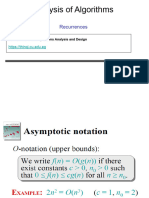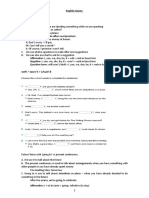0% found this document useful (0 votes)
12 views34 pages03 Recursion
The document discusses recursion in algorithms, covering topics such as recursive procedures, correctness proofs, recurrence relations, and complexity analysis. It includes examples like computing factorials, the Tower of Hanoi, and the Fibonacci sequence, along with methods for solving recurrence relations and analyzing their complexity. Additionally, it explores the concept of smooth functions and their implications in algorithm analysis.
Uploaded by
wabgdinghanCopyright
© © All Rights Reserved
We take content rights seriously. If you suspect this is your content, claim it here.
Available Formats
Download as PDF, TXT or read online on Scribd
0% found this document useful (0 votes)
12 views34 pages03 Recursion
The document discusses recursion in algorithms, covering topics such as recursive procedures, correctness proofs, recurrence relations, and complexity analysis. It includes examples like computing factorials, the Tower of Hanoi, and the Fibonacci sequence, along with methods for solving recurrence relations and analyzing their complexity. Additionally, it explores the concept of smooth functions and their implications in algorithm analysis.
Uploaded by
wabgdinghanCopyright
© © All Rights Reserved
We take content rights seriously. If you suspect this is your content, claim it here.
Available Formats
Download as PDF, TXT or read online on Scribd
/ 34

















































































































